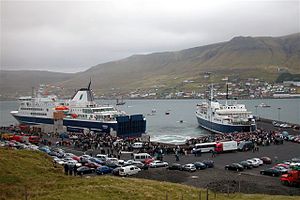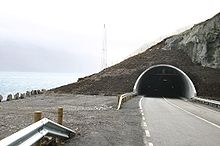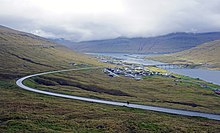Transport in the Faroe Islands
As of the 1970s, the majority of the population centres of the Faroe Islands have been joined to a single road network, connected by bridges and tunnels.International transport, both for passengers and freight, remains difficult due to high costs, long distances, and bad weather, especially during the winter.After World War II, a large part of the Faroe Islands was accessible via ferries and automobiles; private buses and taxis operated as well.It became possible to drive from the capital Tórshavn to Vágur and Tvøroyri in the south, to Fuglafjørður and Klaksvík in the north, and to the airport at Sørvágur in the west.There are no passenger railways on the Faroe Islands due to the difficult landscape, small population, and relatively short distances.A tunnel and rail system supplied a NATO radar installation, now decommissioned, which previously existed on a mountaintop in the southern part of Streymoy Island.The municipalities of Tórshavn, Klaksvík, Eysturkommuna and Sunda operate their own free-of-charge local services, usually referred to as Bussleiðin.Since the early 1980s, Smyril Line has operated a regular international passenger, car and freight service using a large, modern, multipurpose ferry, the Norröna.As a private company, Atlantic Airways continues to provide the Faroe Islands search and rescue capability, under contract to the government.[14] There are public (passenger and freight) heliports at Froðba, Hattarvík, Kirkja, Klaksvík, Mykines, Skúvoy, Stóra Dímun, Svínoy, and Tórshavn (Boðanes).





Strandfaraskip LandsinsMS SmyrilFaroe IslandsferrieshelicoptersWorld War IITórshavnVágurTvøroyriFuglafjørðurKlaksvíkSørvágurVágar AirportBritish during World War IIfirthsHvalbaSandvíkNorðdepilNorðoyatunnilinLeirvíkEysturoyStreymin BridgeNorðskáliNesvíkStreymoycausewayViðoyBorðoysub-sea tunnelsVágarEysturoyartunnilinLøgtingSandoyartunnilinSandoyroundaboutSuðuroyList of tunnels of the Faroe IslandsGoogle Street ViewhighwaysEysturkommunaVestmannaKollafjørðurRunavíkKrambatangiGamlarættgross tonnagedeadweightcargo shippetroleum tankerrefrigerated cargo shiproll-on/roll-offKirkjubøurVelbastaðursub-sea tunnelSuðuroyartunnilinSmyril LineSeyðisfjörðurHirtshalsAtlantic AirwaysAgustaWestland AW139FroðbaList of airports in the Faroe IslandsIcelandDenmarkNorwayScotlandBarcelonaMallorcaLisbonStewart International Airportsearch and rescueRoyal EngineersScandinavian AirlinesHattarvíkKirkjaMykinesSkúvoyStóra DímunSvínoySkopunTransport in DenmarkTunnels of the FaroesIngeniørenThe Washington Postan autonomous constituent countryKingdom of DenmarkHistoryTimelineBritish occupationFæreyinga sagaGeographyGeologyMountainsFjordsCitiesMunicipalitiesRegionsIslandsFugloyHesturKalsoyKolturLítla DímunNólsoyPoliticsLøgting (parliament)SpeakerPolitical partiesPrime MinisterDeputy Prime MinisterCabinetIndependence movementEconomyCompaniesEnergyKróna (currency)Postal systemTaxationTelecommunicationsTourismTrade unionsFaroe IslandersDemographicsEducationLanguageLGBT rights